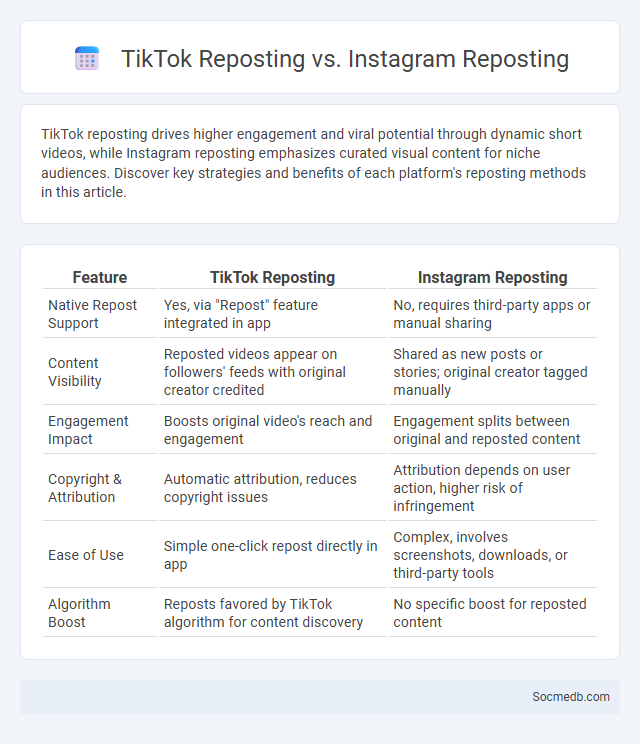
Photo illustration: TikTok Reposting vs Instagram Reposting
TikTok reposting drives higher engagement and viral potential through dynamic short videos, while Instagram reposting emphasizes curated visual content for niche audiences. Discover key strategies and benefits of each platform's reposting methods in this article.
Table of Comparison
| Feature | TikTok Reposting | Instagram Reposting |
|---|---|---|
| Native Repost Support | Yes, via "Repost" feature integrated in app | No, requires third-party apps or manual sharing |
| Content Visibility | Reposted videos appear on followers' feeds with original creator credited | Shared as new posts or stories; original creator tagged manually |
| Engagement Impact | Boosts original video's reach and engagement | Engagement splits between original and reposted content |
| Copyright & Attribution | Automatic attribution, reduces copyright issues | Attribution depends on user action, higher risk of infringement |
| Ease of Use | Simple one-click repost directly in app | Complex, involves screenshots, downloads, or third-party tools |
| Algorithm Boost | Reposts favored by TikTok algorithm for content discovery | No specific boost for reposted content |
Introduction to Reposting on Social Media
Reposting on social media involves sharing existing content from other users to your own profile, helping to amplify messages and increase engagement. This practice leverages user-generated content, expanding reach while maintaining authenticity and community connection. Effective reposting strategies include proper attribution, choosing relevant content, and aligning with brand identity to foster audience trust and growth.
What is TikTok Reposting?
TikTok reposting involves sharing existing videos from other users on your own profile to increase engagement and visibility. This practice often includes saving popular clips and reposting them without altering the original content, aiming to reach a broader audience. Effective TikTok reposting leverages trending hashtags and timing to maximize views and follower growth.
How Instagram Reposting Works
Instagram reposting involves sharing content from one user's account to another's feed or stories, often using third-party apps or manual screenshot methods. Users can credit the original creator by tagging their handle or mentioning them in captions, which helps maintain content attribution and engagement. The platform's repost mechanisms do not have a native feature, so external tools streamline the process by downloading and republishing posts while respecting copyright policies.
General Overview of Reposting Features
Reposting features on social media platforms enable You to share existing content from other users with your audience, increasing engagement and content visibility. These tools often include options for quote reposting, direct resharing, and adding personalized commentary to amplify messages. Many networks like Instagram, Twitter, and Facebook prioritize seamless repost functions to enhance content circulation while maintaining original attribution.
Key Differences: TikTok vs Instagram Reposting
TikTok and Instagram differ significantly in their reposting features, impacting how content spreads on each platform. TikTok's "Duet" and "Stitch" functions allow you to remix or build upon existing videos, fostering interactive and collaborative content creation tailored for viral trends. Instagram primarily relies on reposting through Stories or third-party apps, emphasizing curated sharing rather than direct content integration, which affects your engagement strategies.
User Engagement Comparison: TikTok and Instagram Reposts
Analyzing user engagement reveals that TikTok's repost feature generates higher interaction rates compared to Instagram reposts due to its algorithm favoring viral content discovery. TikTok users spend an average of 52 minutes daily, driven by dynamic reposts that encourage active participation, whereas Instagram reposts often result in passive consumption with lower shareability metrics. Understanding these differences can help you optimize your social media strategy for maximum engagement and audience growth.
Reposting Best Practices Across Platforms
Reposting best practices across social media platforms involve tailoring content to fit each platform's unique audience and format, such as using hashtags on Instagram, tagging original creators on Twitter, and adapting length and style for TikTok or LinkedIn. Ensuring proper credit to original sources maintains ethical standards and fosters community trust while boosting engagement and brand visibility. Consistent monitoring of platform-specific algorithm changes helps optimize repost timing and frequency, maximizing reach and user interaction.
Algorithm Impact of Reposting on TikTok and Instagram
Algorithm impact of reposting on TikTok and Instagram significantly influences content visibility and engagement metrics. TikTok's algorithm prioritizes fresh, original content but also boosts reposted videos that maintain high viewer retention and engagement rates, enhancing viral potential. Instagram's algorithm favors reposted content with strong interaction signals such as likes, comments, and shares, amplifying reach within both followers and explore feeds.
Content Ownership and Copyright Issues
Content ownership and copyright issues on social media platforms are critical for protecting your intellectual property and maintaining control over your original creations. Understanding platform-specific terms of service and copyright laws helps you safeguard your rights and prevent unauthorized use or distribution of your work. Taking informed steps to monitor and enforce ownership ensures your content remains properly attributed and legally protected across digital channels.
Choosing the Right Platform for Reposting Strategies
Choosing the right platform for your reposting strategies depends on your target audience and content type to maximize engagement and reach. Visual platforms like Instagram and Pinterest work best for image-heavy content, while Twitter and LinkedIn excel with concise, text-driven posts. You can boost visibility and interaction by aligning your reposts with the unique features and user behaviors of each social media channel.
 socmedb.com
socmedb.com